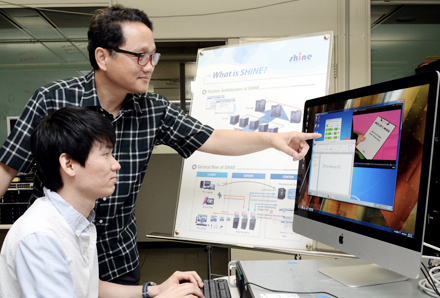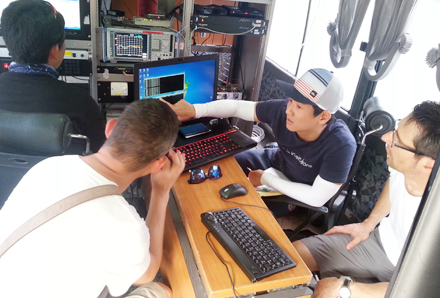
ETRI’s Cloud Technology Selected as International Standard
ETRI announced that the ITU-T (International Telecommunication Union Telecommunication Standardization Sector) had selected as an international standard its technology regarding the functional structure of cloud desktop service, which allows users to place their personal computer environment on a cloud service for convenience.
With desktop as a service (DaaS), users can benefit from the cloud computing technology and use their desktop computer via the Internet connection anytime and anywhere. Selected as an international standard at a meeting held in Geneva, Switzerland, in April 2016, it was approved as an official standard in June 2016.
The DaaS cloud technology was developed by ETRI researchers in 2013 to realize the concept of “my PC on the Internet.” As long as the Internet connection is available, users can open documents in their own desktop computer wherever in the world. This technology is known for initiating “a world without PC.”
As the technology regarding cloud functional structures became an international standard, ETRI strengthened its lead in the international standardization of virtual desktop service technology and secured a significant competitive edge compared to the overseas leading competitors in the industry. South Korea holds the editorship regarding the recently approved standard, and ETRI has continued ongoing cooperation with Microsoft, France Telecom (Orange), and China Telecom for over three years.
The research team has already applied for international standard patents in relation with the technology and will apply for three more within this year. ETRI added that it also made collaborative efforts with the Korea Intellectual Property Strategy Agency to create standard patents.
ETRI explained that the approval for the international standard was a result of joint efforts from various researchers : Dr. Myeong-hoon Oh, principal researcher at the Server Platform Research Section participated as a virtual desktop editor; Dr. Dae-won Kim (principal researcher) and Dr. Byeong-taek Oh (senior researcher) wrote a contribution together; and Dr. Kang-chan Lee, principal researcher at the Protocol Engineering Center supported the standardization process.
Dr. Seong-woon Kim, the research project manager, explained “it is significant that we took the lead in international standardization of the DaaS functional structure following the last requirements for standardization, secured a number of standard patents, and built a firm foundation for overseas technological competitiveness.”

ETRI Successfully Demonstrates Automatic HD-UHD Conversion
On July 28th 2016, ETRI announced its world-first successful field test held in Jeju Island in partnership with Jeju Technopark. In the demonstration, SHVC (scalable HEVC) of the world’s leading broadcasting technology developer was applied to the LDM (Layered Division Multiplexing) that enables simultaneous receipt and transmission of UHD and mobile HD broadcasting through a single channel.
In the test, the researchers used the LDM technology to ensure more efficient receipt/transmission of UHD and mobile HD broadcasting through a single terrestrial channel. In addition, the SHVC technology enabled them to realize UHD broadcasting service with maximum 30% higher efficiency compared to the independent encoding of mobile and stationary services.
The research team explained that the SHVC technology used in the demonstration was not an extended version of the existing HEVC (high efficiency video codec) and that it was able to enhance the efficiency of using frequencies when providing the mobile and stationary services.
For this field test, ETRI and Clever logic provided ATSC 3.0 transceivers, and Technicolor and ATEME in France supported the real-time SHVC encoders and decoders. The participants conducted a joint test together with Jeju Technopark for four days from July 25th 2016.
ETRI stated that in this demonstration they applied the SHVC technology to the LDM technology, which is highly likely to become an international standard in October 2016. The research institute finally confirmed that the technology is able to provide high-quality UHD broadcasting services based on a single occasion of encoding, going beyond the existing method of independently encoding broadcasting content received by and transmitted from each terminal.
As a result, once the technology’s outstanding performance is proved when UHD broadcasting is expanded in the future, the researchers expect that it would be loaded in an array of broadcasting-related equipment and hold a lead in the global market. The research team also showcased a HDR (high dynamic range) technology, which can realize more realistic images based on more sophisticated expression of light and shade. Already applied to smartphones, this technology prevents shadows from appearing when users take photographs in shaded areas.
After ETRI referred the technology to the ATSC (Advanced Television Systems Committee), an international standardization organization in broadcasting, the technology was selected as a baseline technology of ATSC 3.0 for its excellence and was elevated to the Proposed Standard in July 2016.
ETRI plans to fully commercialize the technology in February 2017 through the three terrestrial broadcasting stations in Korea. When 4K UHD broadcasting and mobile HD broadcasting are introduced by policy, the technology is expected to play a crucial role in next-generation broadcasting services and open a new prospect in the field of future realistic broadcasting services.
